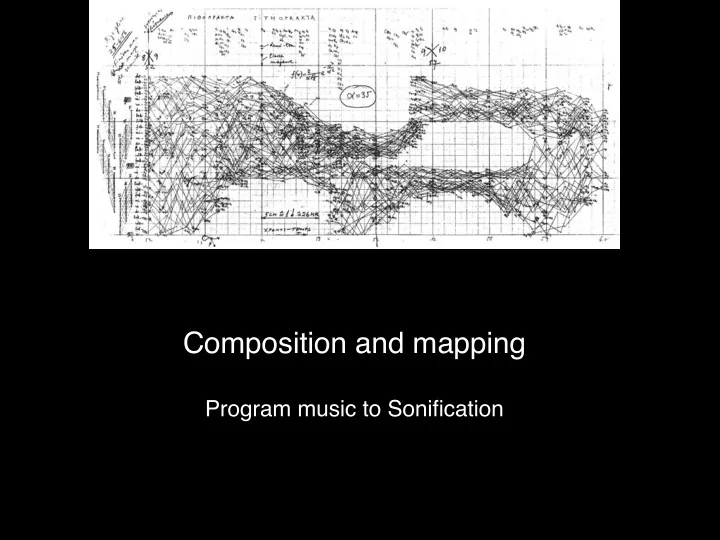

Composition and mapping Program music to Sonification
Jatyantara-Parinamah, for large ensemble (1st movement)
Jatyantara-Parinamah – based on an acoustic analysis and transcription of a stream – understanding of any sound (a stream in this case) as music – technology: recording equipment filtering music notation
Jatyantara-Parinamah background (1st component) background (2nd component) background (3rd component) foreground (4th component)
Program music Transcription Sonification Audification Soundscape composition
Program music
Janequin Le chant des oiseaux
Beethoven, Symphony no. 6 “Pastoral” (4th movement –the storm)
Transcription
Olivier Messiaen, Petites Esquisses D’Oiseaux (European robin)
Re-definition of “Music”
John Cage, The Future of Music, Credo (1937) - “ Wherever we are, what we hear is mostly noise. When we ignore it, it disturbs us. When we listen to it, we find it fascinating. The sound of a truck at fifty miles per hour. Static between the stations. Rain. We want to capture and control these sounds, to use them not as sound effects but as musical instruments. ” John Cage, in The Future of Music, Credo (1937)
John Cage introducing Water Walk in the show “I’ve got a secret”
John Cage, Water Walk
Mapping
“I tentatively term the possibility of (…) eco- systemic mental structures. The suggestion is that some sort of primal separation from such structures rendered mankind both individually conscious and with a deep sense of loss. The religious impulse is evidence for the vestigial need of the individual to reconnect with some larger systemic complexity”. excerpt from Mappings and entrainment , by David Dunn
John Cage, Atlas eclipticalis (1961-1962) for open instrumentation Atlas eclipticalis 1950.0 by astronomer Antonín Be č vár (1957)
Iannis Xenakis, Pithoprakta (1958) for 2 trombones, 46 strings, xylophone and woodblock – based on the statistical mechanics of gases, Gauss's law, or Brownian motion. Each instrument is conceived as a molecule. This theory states that "the temperature of a gas derives from the independent movement of its molecules”
Sonification Conversion of data into audio. Its use may be didactic or artistic.
Matthew Burtner, Iceprints (Ecoacoustics)
Audification Process of taking a vibration signal outside the range of normal human hearing and shifting it into the audible range
Christina Kubisch, Security (from “Electrical Walks”) "Electrical Walks is a public walk with custom-made sensitive wireless headphones by which aboveground and underground electromagnetic fields are detected, amplified and made audible. While the sounds were mixed, they were not altered at all electronically or by any other means.” - Christina Kubisch
Soundscape composition
Hildegard Westerkamp, Cricket voice
David Dunn The sound of light in trees
Geysir, for 7 pianists and electronics
Frequency analysis Re-synthesis / removal of the partials with the lowest amplitude (SPEAR)
Notation From re-synthesis to text file (Orchids)
Notation From text file to XML file, quantization (Max MSP)
Notation Pitch classification code: removing complexity (BASE X)
Dynamics (loudness) Amplitude contour from the DAW
Score Indeterminate notation
Under the sea ice, for string quartet
Under the sea ice, for string quartet
Recommend
More recommend